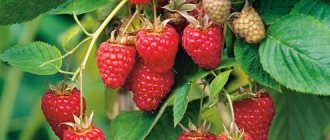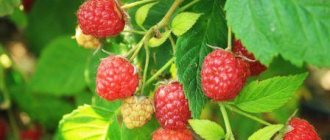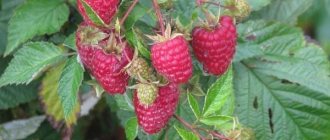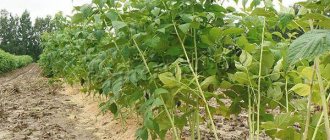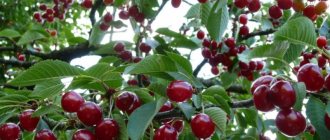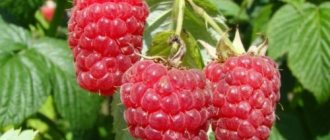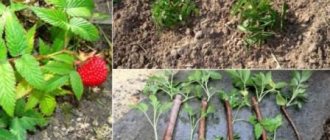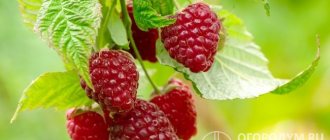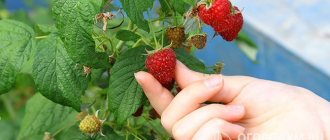History of the variety
The first description of this varietal variety of raspberry appeared in 1994, almost immediately after breeders received a new plant. Among the authors of the variety, Aitzhanova S.D. is distinguished. and Kulagin V.L., who worked under the guidance of the famous breeder Kazakov I.V. As parent forms for new raspberries, they used the then popular varieties Brigantina and Bryanskaya , from which the large-fruited, non-remontant Volnitsa inherited all its best qualities.
In addition, along the “parental” line of the described raspberry, among the relatives is the Novost Kuzmina variety, which is deservedly considered one of the oldest and at one time became the basis for the creation of Bryansk raspberries. Raspberry Volnitsa is included in the State Register of the Russian Federation and is recommended for cultivation in the North-West region of the country.
Did you know? The first raspberry plantings on the territory of Rus' appeared in the 1100s, thanks to the efforts of Prince Yuri Dolgoruky. The area of raspberry fields of those times was so large that forest animals could freely walk around them, feasting on delicious and ripe raspberries.
Botanical description
When describing Volnitsa raspberries, it is worth paying special attention not only to the characteristics of the berries, but also to the appearance of the bushes, which in this case reach a height of 170–200 cm. The shoots of the plant cannot be called erect and most often they are slightly inclined or scattered in different directions (according to one According to theories, it was the free arrangement of the branches of the bush that served as the basis for the name of the variety).
The branches of Volnitsa are of medium thickness, brown in the first year and light brown in the second year of growing the plant. Starting from the tops to the very base, they are all covered with small but very prickly purple thorns. The leaf blades are rich green in color, with a well-defined “crumpled” surface, but without pubescence.
The leaves densely cover the shoots, and their curling is medium or low. Replacement shoots grow at an average speed, so in one season no more than nine of them usually appear, and the mother bush can direct all its forces to the formation of fruits.
Raspberries are formed only on long and powerful shoots from last year. Often, about 10–12 tassels appear on one such branch, from which up to 20 bright red cone-shaped berries with a large number of small seeds on the surface later grow.
The weight of one sweet and sour raspberry is 3.5–5 g.
Characteristics of Volnitsa raspberries
The plant is spreading, up to 2 m high, and needs staking. Young stems have an almost imperceptible waxy coating and a few thorns. Bushes older than two years are light brown in color, covered from top to bottom with straight, not too sharp purple thorns;
- The yield per season can reach 4 kg per bush;
- The leaves are large, rich green in color, wrinkled, with a medium degree of curl, no pubescence.
- Frost-resistant crop, can withstand temperatures down to -30°c. During the cold season, in areas with snowy winters, it bends down.
- Raspberry Volnitsa is resistant to diseases and pests. The only danger is the kidney mite.
- Used fresh, good for canning, freezing and drying.
Berries
The berries of Volnitsa raspberries have an attractive appearance - classic, typical of the usual raspberries.
The average berry size is 3.5 grams. Minimum weight 3 grams, maximum 4–5 grams.
The shape resembles a blunt cone. The berries are always standard, very even; There are no ugly ones. The drupes are one-dimensional, tightly welded to each other.
The color is light crimson, with an attractive shine. The surface is covered with small hairs - this is how the “grandmother” genes (variety Novost Kuzmina) appear.
The taste is rated 4 points. The berries are not cloying, sweet and sour. Information that they are devoid of aroma is not true. The smell is not too intense, but very subtle and pleasant. The flesh is tender. The seeds are small.
Transportability is average.
The shedding rate of ripe and even overripe fruits is very low. This is a very valuable quality for raspberries. Unripe berries are not removed from the fruit at all.
Bush
Plant height is average. The shoots are 170–200 cm long.
The bush is not prone to thickening. Renewal shoots grow in moderate quantities (on average 7–9 pieces per bush). This is very convenient for busy gardeners: you don’t have to spend a lot of time thinning. The raspberry plantation is well lit and ventilated, reducing the risk of infectious outbreaks.
The stems are of medium thickness, in the first year of life they are colored brown and covered with a waxy coating. After wintering they turn light brown.
More on the topic: Remontant raspberries of the Izobilnaya variety
The thorns are not aggressive, almost not prickly. They are medium in size, with a dark base, distributed evenly along the entire length of the trunk, not too densely.
The foliage is abundant, dense, healthy. It is slightly curled down, has a rich color and strong corrugation.
Shoots are formed in small quantities. This is an important distinctive feature of the Volnitsa variety; it has its pros and cons. Not very good for rapid reproduction. But the plantings do not thicken.
Raspberry Volnitsa does not spread much around the site, it is not aggressive. And most importantly, abundant growth would take a lot of strength and nutrition from the main bush. The high productivity of Volnitsa is a direct consequence of the small growth of shoots.
Characteristic
The first thing gardeners pay attention to when choosing a variety is its maximum yield and the ability to grow in different climatic conditions, so before purchasing seedlings of the Volnitsa variety, it is worth studying the following features of this varietal variety of raspberries.
Drought resistance, frost resistance
Malina Volnitsa feels equally good both in the southern and middle regions of the country and in the northern regions of the Russian Federation, as it tolerates winter temperature drops down to -30°C . For maximum preservation of the plant during a period of significant drop in temperature, it is recommended to bend the shoots to the soil, helping to create a thick snow layer.
In the summer, the bushes tolerate drought well, but in order to form a juicy and sweet harvest during the period when the ovary appears on the bushes, you should take care of a sufficient amount of moisture under the raspberry tree.
Productivity and fruiting
On the territory of Russia, as well as in neighboring countries (Ukraine and Belarus), fruiting of the bushes of the variety begins at the end of June, which makes it possible to classify the crop as a group of plants with a medium-early ripening period. In the rest of the territory, these raspberries are rather mid-season, and the specific harvest dates vary depending on weather conditions in the current year.
In warm weather, up to 4 kg of berries can be harvested from one bush during the entire growing period. Even if these are not the maximum indicators for this crop, they will fully satisfy the needs of an ordinary summer resident, especially since the quality of the fruit is excellent.
Reviews
I planted the variety three years ago. I read in the description on one of the sites: “Raspberry Volnitsa is a high-yielding, mid-early variety of universal use, not remontant.” I was completely satisfied with this description. In my opinion, remontant varieties are difficult to grow in the Moscow region, they do not have time to ripen, or I simply planted something inappropriate. Productivity is also good, picking berries, collecting them in such a way that there is enough for everything - both to eat raw and to make preparations for the winter. Mid-early ones are also good, I love raspberries right after Victoria, then cherries appear and plums and apples, I don’t really want raspberries in the fall.
Currently, the garden market is rich in different types of raspberries, but if you want to get a rich harvest with minimal costs, then Volnitsa raspberries are your good choice.
Sources:
https://dachadecor.ru/yagodi/malina-volnitsa-opisanie-visokoproduktivnogo-krupnoplodnogo-sorta https://sort-malina.ru/malina-volnica/ https://egemalina.ru/sorta/opisanie-sorta-maliny -volnitsa
Advantages and disadvantages
Like any other raspberry varieties, Volnitsa has both strengths and weaknesses. Therefore, before planting a plant, it is worth studying all its possible advantages and disadvantages.
- The first group can include the following characteristics:
- high frost resistance (up to -35°C), and the bushes can withstand even icing, which is explained by the high flexibility of the shoots (they bend towards the ground, but do not break under the weight of ice, which is especially valuable when grown in the northern regions of the country);
- good berry yield;
- excellent resistance to fungal diseases and popular pests such as raspberry beetle and stem fly;
- resistance of berries to falling off during ripening;
- excellent transportability of the crop;
- the presence of a large amount of dry matter in the composition, which is very important when creating preserves, jams, and juices.
- As for the disadvantages of this variety, they include:
- the need to organize supporting trellises, which are simply necessary for spreading shoots;
- sometimes there is an overly strong connection between the stalk and the berry, which somewhat complicates the harvesting process;
- a large number of prickly thorns on the shoots;
- susceptibility to leaf bud mite, which is very fond of raspberries of this variety.
With proper organization of plant care, you can “turn a blind eye” to the small shortcomings of the variety, since the positive qualities surpass them.
Description
Raspberry Volnitsa forms a spreading bush that requires staking to supports. The shoots are erect, 1.5-2.0 m high. Young branches are light green, two-year-old branches are brown, covered with thorns. Fruit branches per bush up to 12 pcs. The leaves are well developed, dark green, wrinkled, without edges. There are few root shoots; 5-7 replacement shoots are formed per season. The clusters are long, powerful, strewn with fruits. There are up to 20 ovaries on each.
You might be interested! Description of the most popular Polish raspberry - the Polka variety.
The berries are sweet and sour, aromatic, tasty (tasting score 4 points out of 5), large (weight 3.5-4.0 g), bright red in color, covered with villi. The shape of the fruit is cone-shaped, smooth, without flaws. The drupe holds tightly, the seeds are small, soft, and almost unnoticeable.
Advantages of the variety
- high frost resistance down to -30 (35) o C, tolerates icing well. The shoots are flexible. A freeman can bend to the ground from the cold, but not break off. Growing regions: from the southern regions to Siberia;
- abundant fruiting, yield from one bush up to 4 kg;
- resistance to fungal diseases, not affected by raspberry beetle (imago) and raspberry stem fly;
- fruits do not fall off when ripe;
- good transportability of the crop;
- berries contain more dry matter, which is good for making preserves, jams, and juices.
Disadvantages of the variety
- The freemen need the construction of trellises;
- strong adhesion of the stalk to the berry (it’s harder to pick, but the berries don’t fall off);
- a large number of thorns;
- May be affected by leaf bud mite.
Landing Features
Planting any variety of raspberries begins with choosing the appropriate timing for the procedure, the planting material itself and the place for planting the raspberries. Each of these stages has its own characteristics, which every gardener should know about.
Deadlines
Read more
Autumn planting of raspberries: step-by-step guide, advantages and disadvantages You can plant Volnitsa raspberry seedlings both in spring and autumn, but winter planting in the middle or southern regions is considered the best option, as it helps to get the first harvest of fruits faster.
The ideal time to carry out planting activities in this case is the end of September or the beginning of October , when the plant still has enough time before the onset of the first frost.
Spring planting (around the middle or end of April) is more relevant for northern regions, since it is more difficult to predict the onset of frost in the fall.
Over the summer, the shrubs will definitely have time to adapt to the new place and will be able to safely survive the winter.
Choosing a suitable location
When choosing a site for planting young Volnitsa plants, you should pay attention only to moderately humid, well-lit areas, preferably located on a small hill. The optimal location of groundwater is no closer than 1.5–2 m from the surface of the site, which will guarantee the absence of stagnation of moisture and possible freezing of the root system in winter.
It’s good if the area you choose is on the south side of the site, not far from the fence or outbuildings located to the north. By planting bushes 1.5 m from them, you can protect the plantings from cold gusts of wind and drafts.
If you plant several raspberry bushes at once, you should leave at least 70–100 cm of free space between neighboring plants, taking into account further growth of the plant.
Preparing the soil for planting raspberries is carried out either in the fall (during spring planting) or a month before planting activities in the autumn and involves enriching the substrate with rotted manure or compost, as well as organic mulch at the rate of 3–5 kg per 1 m² of area.
Important! When using green manure plants (for example, mown mustard) to fertilize, it is worth eliminating the possibility of harmful weeds getting into the soil, which often become a home for pathogens and pests in the winter.
Selection and preparation of planting material
Volnitsa raspberry seedlings suitable for planting must have a well-developed root system and be completely healthy, without signs of disease or pest damage. The leaves of the aboveground part may have a light green color, but the presence of spots or dark edges on them is not allowed.
For preventive purposes, the rhizome of selected seedlings should be additionally treated in a weak solution of potassium permanganate (the roots are dipped in it for about half an hour), and then dipped in any available root formation stimulant (for example, the well-known drug “Kornevin”). In the latter case, the solution is prepared according to the instructions on the package, after which the rhizome is placed in the prepared liquid for a day.
An alternative treatment option may be dusting the root system of plants with a crushed compound immediately before planting on the site. It is advisable to trim the stem of the seedling to a height of 40 cm, so that the subshrub does not waste energy on preserving shoots and foliage, but directs all its energy to the formation and strengthening of the rhizome.
If the root is damaged, cut or torn, you should fill the bottom of the planting hole with ready-made soil mixture or compost, and mulch the plantings on top to better retain moisture. Fresh manure should not be used for fertilizer, which will help prevent burns to the plant root system.
Did you know? To increase raspberry yields by 60–100%, it is worth organizing raspberry fields near the apiary. When collecting nectar, bees transfer pollen well, fertilizing a large number of flowers.
Landing algorithm
Planting Volnitsa raspberries can be done in several ways: individual bushes or trench plantings. In the first case, it is necessary to dig planting holes measuring 40x50 cm in advance and, after filling them with a nutritious soil mixture, plant the raspberry bushes themselves, carefully straightening their roots.
There should be at least two meters of free space between adjacent rows of plantings, and about 1 m between plants in a row. When filling up the roots, make sure that the root collar remains above the soil surface , because if this part is deepened excessively, rotting of the root system may begin, which will lead to further death of the entire bush.
For trench planting of raspberries, you need to organize separate ditches 50 cm wide and about 45 cm deep . In this case, there should be at least 1 m of free space between adjacent rows, and at least 40 cm between the plants themselves. 15 cm of soil mixture prepared from manure, fertile soil and mineral fertilizers with the possible addition of a small amount should be poured into each organized trench. ash.
The raspberry seedlings themselves are placed on top of the nutrient base, carefully filling them with soil to the level of the root collar. At the end of the procedure, all that remains is to water and compact the substrate well, if necessary, additionally mulching it with peat or sawdust.
Landing
For planting, it is best to choose a well-lit place along the fence or a corner of the site. Raspberry Volnitsa is demanding on soil fertility; light loamy or sandy loam soils are ideal for its cultivation. Tomatoes, strawberries and potatoes are undesirable as predecessors, as they have similar diseases.
Raspberries are planted in two ways: individual plants in holes or using a strip method in trenches.
Planting with individual bushes
Dig holes 40 cm by 50 cm, pour the planting mixture into them, treat the roots with mullein solution, lower them into the hole, and sprinkle with soil. The bushes are planted no closer than 1 m to each other, with a space of 2 m between the rows. The root collar is left slightly above ground level: during watering, the soil will settle and the collar will be level with the ground. Deepening is dangerous: the roots may begin to rot due to excess moisture.
Trench planting
Dig ditches 50 cm wide and 45 cm deep. The space between the rows is 1 m, between the bushes - 40 cm. A 15-centimeter layer of the mixture is added to the trench, which is prepared from manure, fertile soil and mineral fertilizers. Allowed to add a little ash.
Important! When planting, double superphosphate should be added to the nutrient mixture. But you should refrain from nitrogen-containing fertilizers - they negatively affect rooting.
If necessary, water the bushes after planting. The soil is mulched with humus or peat.
Healthy seedlings planted in prepared soil, with proper care, will reward you with an abundance of tasty and juicy berries.
Raspberry Volnitsa is an absolutely unpretentious plant that even a novice gardener can handle caring for. To obtain a high harvest during the season, you need to properly and timely care for the plantings. Care should begin as soon as the snow melts.
The main stages of caring for raspberries:
- In the spring, pruning is carried out. The tops that are frozen are cut off to the healthy part. Weakened and thin shoots are also cut out. Leave about 6 - 8 shoots in the bush. During the summer, excess growth is removed. In autumn, more stems are left in case of frost damage. Note! To obtain healthy and high-yielding bushes, it is important to prune correctly in the spring.
- Before the buds bloom, treat the bushes and soil with 3% Bordeaux mixture or 1% copper oxychloride solution.
- At the beginning of spring, the plantings are treated with a 3% solution of nitrafan or 5% urea.
- In early spring, a nitrogen-mineral composition is introduced, in which nitrogen is the predominant element. Before flowering, raspberries require foliar feeding, and the main components should be: potassium, phosphorus, calcium and magnesium.
- If the winter is not snowy, the plants are watered in the spring: optimally, one bucket per plant. The next two waterings are carried out in June: there should be two buckets of water per linear meter. Important! Excessive watering can lead to root rot and death of the bush. When watering, precipitation should be taken into account.
- Weed regularly and carefully loosen the soil after heavy rains. At the same time, damage to the root system is avoided. Thanks to loosening, the roots of the plant will be able to “breathe” freely, and excess moisture will easily “go away”.
Caring for raspberries is quite simple. Following simple procedures will allow you to enjoy a generous summer harvest.
Care
Almost immediately after planting the Volnitsa raspberries, a long stage of caring for the bushes begins on the site. Its main aspects are timely watering and fertilizing of plantings, as well as regular pruning of young bushes in order to form a large and high-quality harvest. Of course, each of these actions has its own characteristics.
Watering
Volnitsa is a relatively drought-resistant plant, so overwatering is unacceptable when growing it. To determine the need for the next watering, always evaluate the condition of the top layer of soil, and when it dries out, add liquid in measured doses.
On average, 3–5 waterings are performed in one season: with the arrival of spring, after a winter with little snow (at least 10 liters of water are poured under one bush), then the procedure is repeated twice in June - at least two buckets of water must be spent on one plant. Further watering is carried out as needed, with slight restrictions during the ripening period of the berries (excessive moisture can cause the fruits to become very watery).
Loosening and mulching the soil
As soon as the moisture is completely absorbed, you can begin to remove weeds by loosening and mulching the soil. Since the raspberry root system is not very deep, it is worth loosening the soil no more than 8–10 cm deep. As a five-centimeter mulching cover, you can use peat, sawdust or ordinary mown hay, changing the covering regularly once every few weeks.
Top dressing
The first feeding of Volnitsa raspberries is carried out 2-3 years after planting the bushes , although only in the case when a sufficient amount of organic matter and mineral compounds were used during planting activities. Subsequently, in the spring before the snow melts, it is useful to add nitrogen-mineral compositions (necessary for plants to gain green mass) into the tree trunk zone of the bushes.
Before flowering, potassium-phosphorus mineral fertilizers containing calcium and magnesium will be beneficial for plants. In the latter case, foliar feeding is considered more appropriate, which is carried out by spraying plants from a spray bottle.
Preventive treatment of plants
To prevent raspberries from being damaged by diseases and pests, it is important to spray them in a timely manner with a three percent solution of Bordeaux mixture and a one percent solution of copper oxychloride. Both drugs are used before buds bloom on the bushes.
Bush pruning
Raspberries are pruned twice a year: in spring and autumn. With the arrival of the first warm weather, all frozen and broken branches during the winter must be removed, and the frozen tops of healthy specimens are shortened to the first healthy bud (as a result of the procedure, no more than 6–8 branches should remain on one bush).
In the fall, all fruit-bearing shoots, as well as branches damaged by diseases and pests, are subject to cutting. In the summer, it is necessary to regularly remove excess root shoots, thereby limiting the growth of raspberries.
Important! After autumn pruning, you need to leave more strong and healthy shoots on the bushes, since some of them may freeze in the winter, which will make the bush not so lush in the spring.
All work is carried out using sharp pruning shears, which cut off excess shoots to the very base, leaving no stumps.
Caring for Volnitsa raspberries
Watering
It is necessary to water the bushes of this variety throughout the season. This is especially important in the absence of precipitation and during periods when plants have an increased need for moisture: during flowering and during periods of ovary formation and fruit filling.
At the same time, it is important not to overfill the raspberries, but also not to allow the surface layer to dry out. To do this, the soil in the raspberry garden is mulched with mown grass or straw.
Tall raspberry bushes require staking. When planting plants in individual bushes, tall wooden or metal stakes installed in the center of the bush or a net located around it are used as support.
When planting raspberries in a trench, it is best to use a trellis tying method. To do this, install poles at a distance of 2-2.5 meters and stretch several levels of wire between them. This simple design perfectly holds the bushes even without tying them up.
Trimming
Volnitsa is trimmed twice a year. In the spring, frozen and damaged branches are cut out, and in the fall, all shoots on which there was a harvest. During the summer season, no more than 5-6 of the strongest branches are left from the new growing branches; weak-looking stems must be removed.
It is important to carry out pruning without leaving stumps, otherwise they will become a breeding ground for pests and fungal diseases.
Experienced gardeners prune raspberries in the summer to increase productivity. It is performed as follows:
- In the last days of June, as soon as new shoots reach a height of about a meter, they are shortened by 15-20 cm. This will stimulate the active growth of side shoots.
- In July, after harvesting, all old branches are cut off at the root. As a result, the bush will direct all its energy to the development of new, already growing stems.
- In spring, the lateral processes formed over the last summer season are shortened by 10-12 cm.
More on the topic: Remontant raspberry Mulatto
As a result of such manipulations, the bush forms a large number of fruit clusters. You can prune Volnitsa raspberries in this way every year.
Top dressing of the Volnitsa variety
If the planting work was carried out according to all the rules and the soil for the raspberries was well filled, then the raspberry tree does not need to be fertilized for the first two years.
In the future, fertilizers are applied annually, alternating organic compounds with mineral ones. In spring, it is best to water the bushes with a solution of fertilizers with a high nitrogen content.
Just before flowering, complex fertilizers are added to the soil in dry or diluted form, which will saturate the soil with a full range of micro- and macroelements.
After harvesting, the plant has an urgent need for phosphorus and potassium, so the fertilizer must be appropriate.
Raspberry Volnitsa responds well to fertilizing, the berries become larger and sweeter, and the harvest is more abundant. On poor soils, fruiting will not be rich, and over time it may stop altogether.
Harvesting and storage
Harvesting and further storage of fruits when growing the Volnitsa variety are carried out according to generally accepted recommendations:
- It is worth picking ripe berries in the morning, but after the dew has disappeared from the leaves;
- When performing the procedure, always monitor the force of pressure on the berries so as not to crush them (they cannot be stored in this form for a long time);
- It is better to place the harvest in shallow wooden containers with a sufficient number of holes for filtration (spread the raspberries in one or at most two layers, trying not to compress the fruits);
- It is better to place boxes with raspberries in a cool room, with an air temperature in the aisles of 0...+3°C, where they can stand for about 2-3 days;
- For long-term storage of the harvested crop, it will have to be frozen or processed into preserves, jams, and juices, especially since the described variety is distinguished by its versatility of use.
To prevent raspberries from becoming overripe, it is worth inspecting the bushes daily from the beginning of July. and, as necessary, remove new ripened fruits. This option is perfect for those who like to enjoy fresh berries and want to maximize the fruiting period of the crop.
Preparing for winter
In regions with snowy winters, Volnitsa raspberries do not need additional shelter during the cold season, so it is enough to bend the cut shoots to the ground, further promoting better formation of a snow layer on them.
In areas with little snow in winters and frequent gusts of cold wind, it is better to cover raspberry bushes so that the shoots do not dry out or freeze. Before performing the procedure, the branches are tied and bent to the ground, and after fixing in this position, they are covered with spruce branches or any other non-woven material (spunbond is especially popular).
Growing and care
Praise does not require much attention. The main agrotechnical measures include timely watering, fertilizing and pruning.
Watering
The Pokhvalinka variety requires enough moisture, otherwise high yields will not be achieved and the berries will not be fleshy and juicy. Drip irrigation in several rows of pipes is preferable, since the roots grow widely. Irrigation by sprinkling in sunny weather can lead to burns of foliage and stems, and in cloudy weather it can lead to the development of fungal diseases. The construction of drip irrigation is quite an expensive undertaking. As an alternative, you can dig grooves along the rows of raspberries and let water flow through them, or the simplest thing is to water them at the roots. The choice of watering method depends on the size of the raspberry tree; several bushes can be watered with a watering can, but when servicing the plantation you cannot do without automation.
When growing on a personal plot, Pokhvalinka is watered at least once a week (in the absence of precipitation). Each bush requires at least 10 liters. water.
Trimming
If you plan to get two harvests a year, then pruning of two-year-old shoots is carried out immediately after the end of fruiting (usually in July). All the energy of the bush in the second half of summer will be aimed at forming a crop of annual shoots. Annual shoots are not pruned after the end of fruiting; they will be the source of next year’s summer harvest.
When berries are collected only from the shoots of the current season, in the fall the entire raspberry tree is cut out completely at the root. In the southern regions, pruning is done in the fall, in cold regions - in the spring, so that the raspberry branches help with snow retention.
Full pruning has a number of benefits. Removing the above-ground part prevents the development of diseases and pests and simplifies the preparation of the plant for winter. Next year's harvest will be late, but in terms of yield it will be comparable to two harvests grown according to the scheme of ordinary garden raspberries.
Top dressing
Remontant raspberries must be planted in fertile soil. Fertilizing begins in the second or third year after planting; at first, the plant will have enough nutrients added to the hole during planting. In early spring, nitrogen fertilizers are applied so that the plant grows and actively increases green mass. During flowering and fruit set, feed twice with mullein (1:10) or bird droppings (1:20). Potassium salt can be mixed into organic fertilizers, since when fed independently, it is quickly washed out of the soil.
Phosphorus-potassium fertilizers, which are applied in the fall, will contribute to a good harvest next year.
Protection from diseases and pests
The set of measures to protect against pests and diseases includes thinning the bushes from excessive thickening. It is also necessary to ensure that moisture does not stagnate and does not provoke fungal diseases of the roots. Related crops that have weak immunity to disease should not be planted next to raspberries.
Preparing for winter
Raspberries of the Pokhvalinka variety can withstand frosts down to -30 degrees. Preparation for winter depends on how many harvests are planned for next year:
- if a single-harvest scheme is chosen, then all stems are cut flush to the ground, and the raspberry tree is mulched with a thick layer of mulch (10-15 cm).
- in a two-crop scheme, abundant moisture-recharging irrigation is carried out in the fall, annual shoots are bent to the ground. In the conditions of the Urals and Siberia, it is advisable to cover the bushes with any non-woven material, for example, spunbond.
Reproduction methods
By growing the Volnitsa variety on your plot, you will not have any problems with the expansion of the raspberry tree, because the bushes annually form a sufficient amount of shoots from the accessory sinuses of the rhizome. By autumn, strong and well-developed root shoots appear 30 cm from the mother stem, which need to be separated and planted in another suitable place.
However, if the option of using shoots as planting material does not suit you, you can propagate raspberries by cuttings. To do this, with the arrival of spring, you need to dig a small trench, 30–40 cm wide and 40–50 cm deep, and pour a mixture of 200 g of superphosphate, 150 g of potassium fertilizer and two buckets of rotted manure onto the bottom of the recess, thoroughly mixing all these components.
As a suitable cutting, select a healthy and strong-looking branch, cut off part of its buds, and then bend it to an organized hole and, covering it with substrate, observe the development of the root system. In place of the cut part, a new rhizome very quickly appears, and branches develop from the remaining buds.
Throughout the summer season, the planting site must be thoroughly watered, and on especially hot days, it must be covered with a translucent film, thereby creating a greenhouse. As soon as the emerging shoots are well established, you can separate the branch from the mother bush and care for it as an independent young plant.
Diseases and pests
Compliance with the rules for growing raspberries usually guarantees a relatively easy harvest, especially since the specified plant is considered resistant to the raspberry beetle, stem fly and most fungal diseases.
The most common enemies of the crop are bud mites and gall midges, although the presence of raspberry weevil on the stems is not excluded. All of them attack weakened or damaged plants, especially those with cracks and broken shoots.
Timely sanitary pruning of bushes helps prevent the massive spread of pests, but to completely get rid of the problem it is worth using one of the popular insecticidal preparations: for example, Fufanon, Inta-Vir, Inta-CM, Iskra.
Spraying with them is carried out only before the bushes bloom, during the development of the first buds (a comma is needed here, since the second part of the sentence clarifies the first). With regard to fungal diseases, treatments with Fitosporin-M, Bordeaux mixture solution, and Horus composition will be relevant. Application standards and procedures for using each of them are given in the manufacturer's instructions.
The main preventive methods for growing raspberries will be control of soil moisture, dosed use of fertilizers, compliance with the requirements of crop rotation and optimal proximity of crops. In addition, spring spraying of plantings with a solution of Bordeaux mixture and copper sulfate will not be superfluous, especially on plantings that have already suffered from pests or diseases.
In general, growing the Volnitsa variety is not particularly difficult and if the standard requirements for cultivating this varietal variety are observed, no difficulties should arise. With moderate efforts, you can soon get a tasty and healthy harvest of fruits.
Features of care
There are no particular difficulties when growing the plant. Even novice gardeners manage to get good harvests:
- Since the Volnitsa raspberry variety is tall, it requires staking. Plants grown by the trench method are secured to a trellis. A reliable stake is driven in next to single plantings.
- Like any plants, plantings are watered as needed. The Volnitsa raspberry variety especially needs moisture during flowering and fruiting. In hot weather, watering is increased; you can also water the plants over the leaves early in the morning or after sunset.
- Volnitsa loves loose soil and does not tolerate weeds. Both types of work are performed after watering. Fertilizers are also applied to well-moistened soil twice a year: in July and August. The variety responds well to infusions of mullein, bird droppings and green grass.
- Sanitary pruning of bushes is carried out in the spring, removing diseased and frozen shoots. In summer, grown replacement branches are cut off so that they can branch out. This procedure also allows the shoots to ripen well before winter.
- The Volnitsa variety can bear fruit in one place for up to 15 years. It is clear that during this time diseases and pests accumulate, despite resistance and good immunity. Therefore, preventive procedures are an integral part of planting care. Traditional medications are used, taking into account the recommendations for use.
